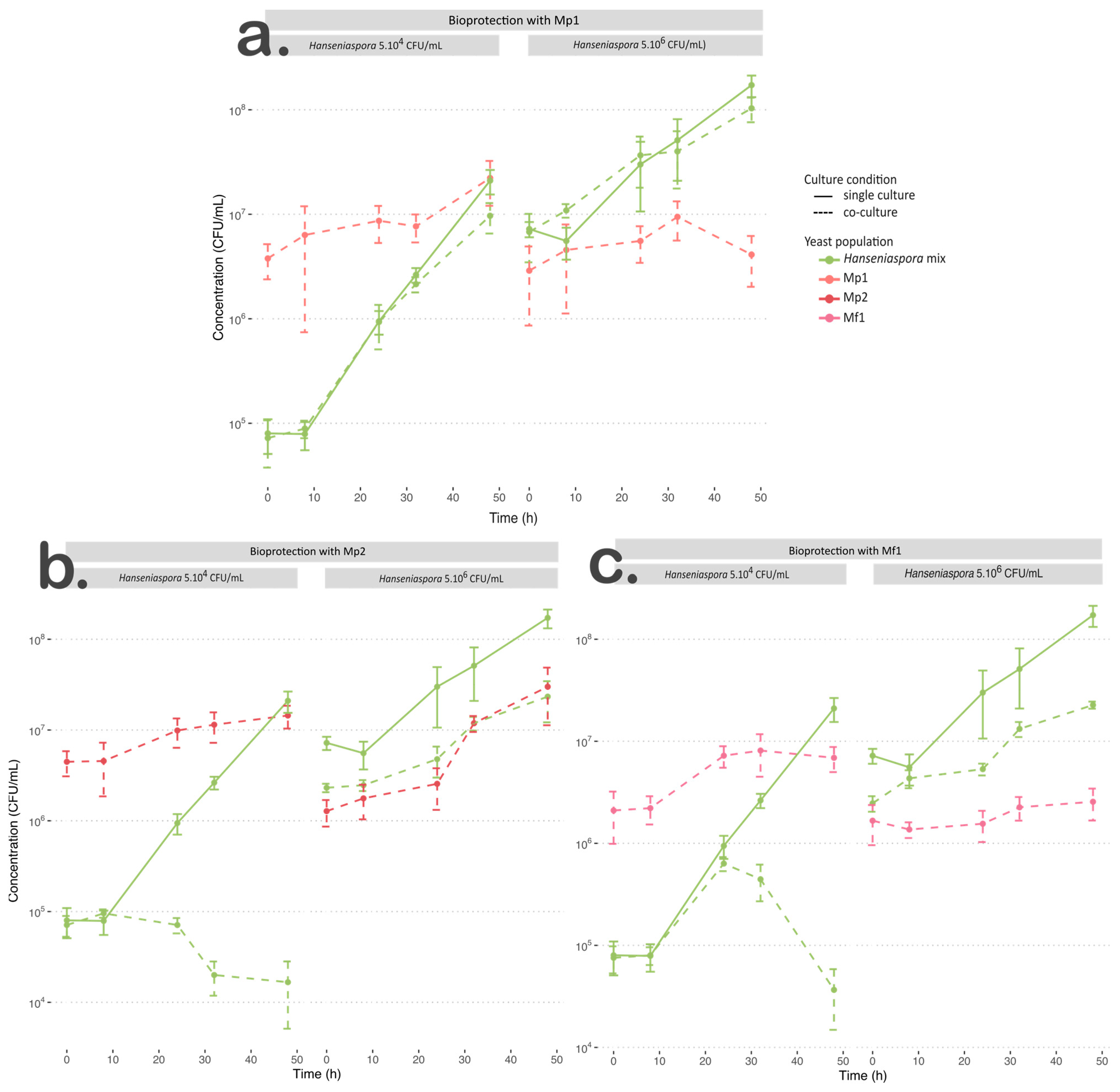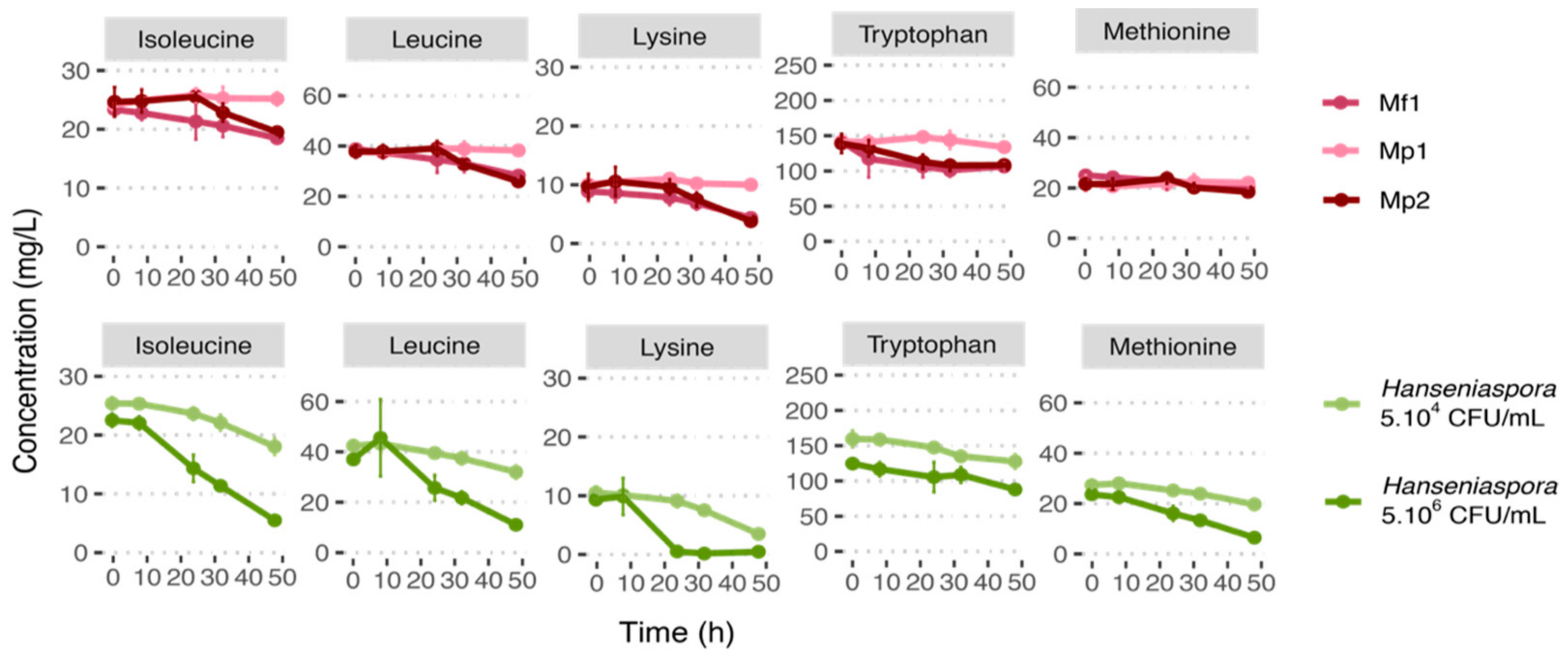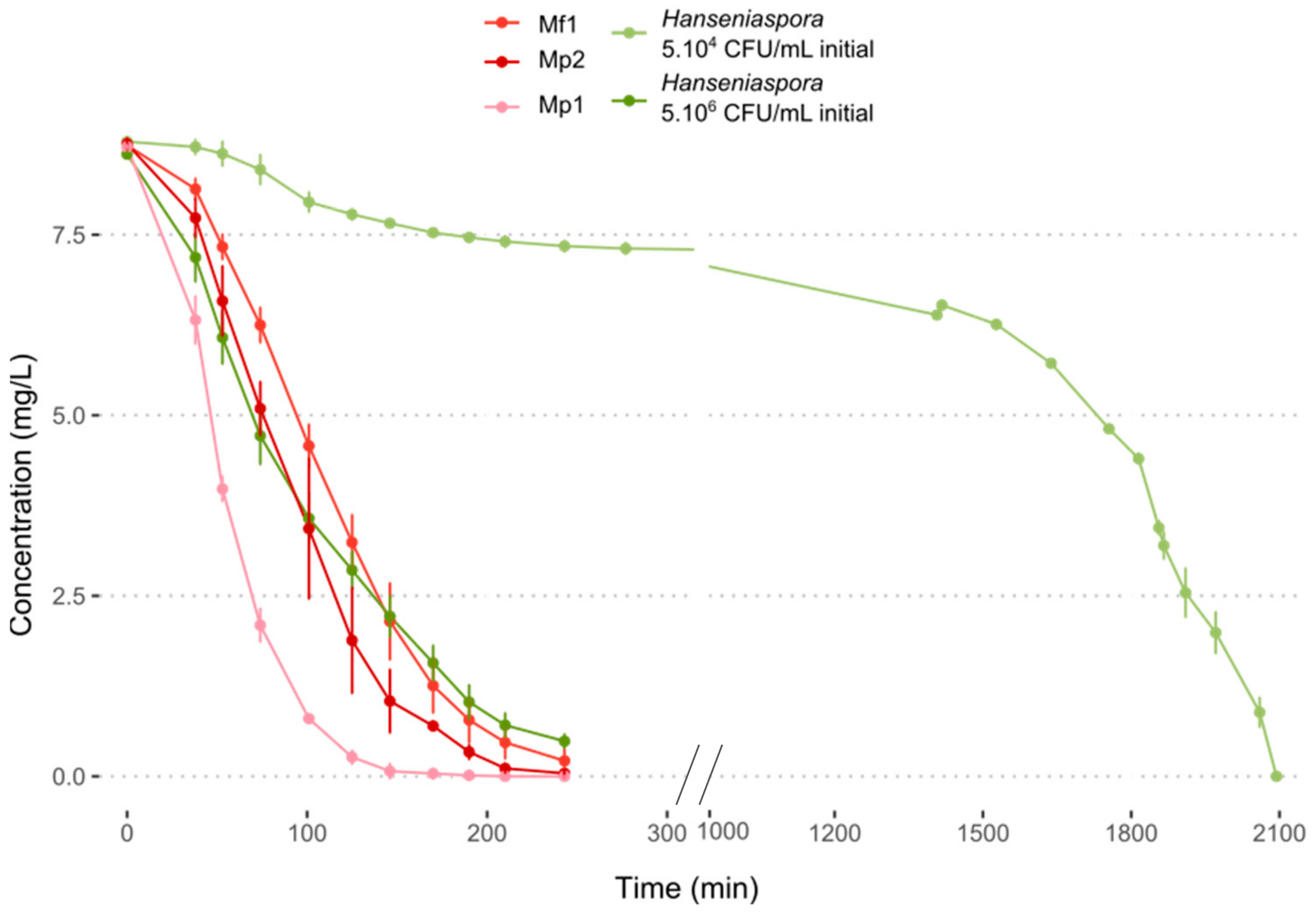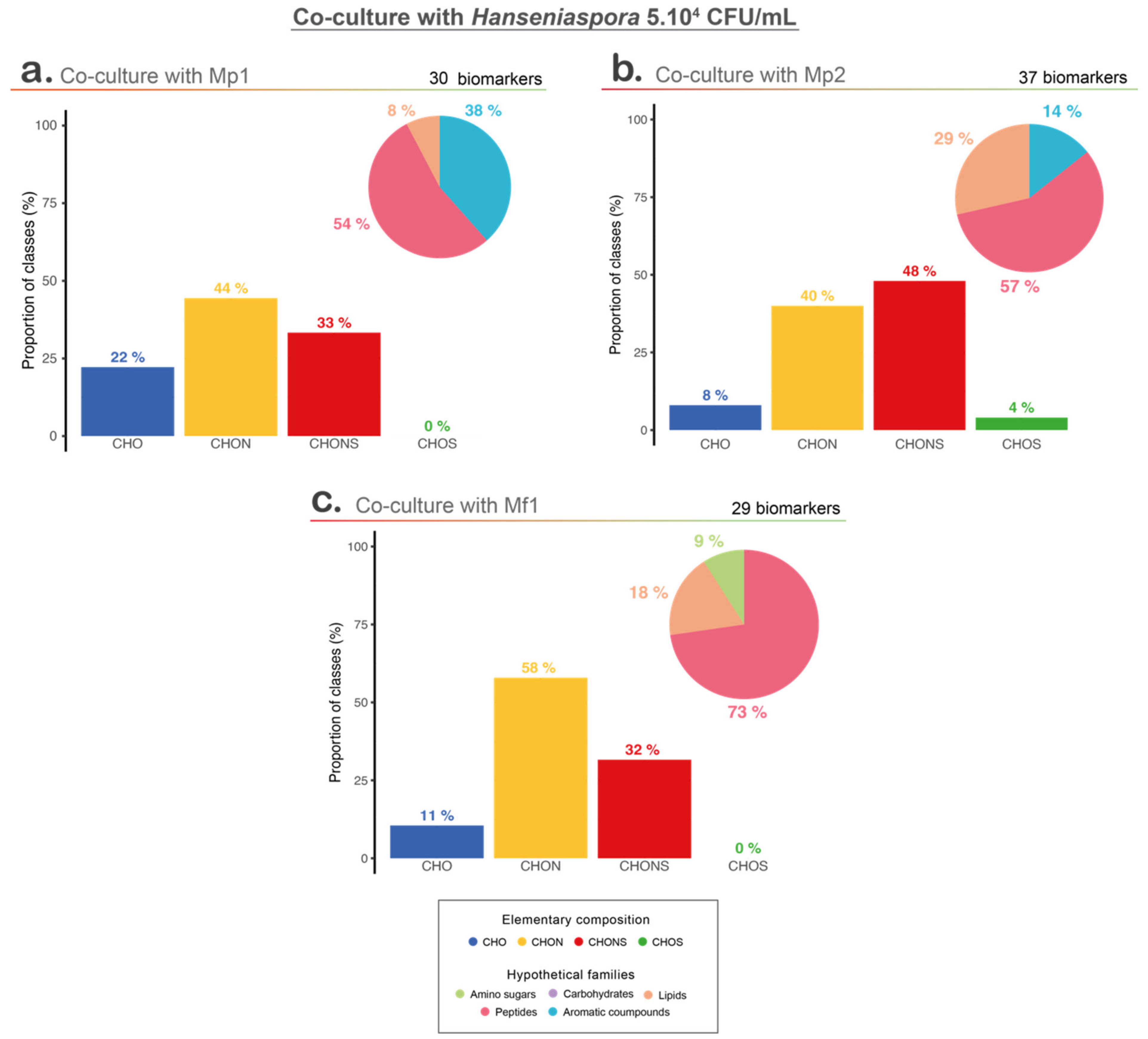Bioprotection Efficiency of Metschnikowia Strains in Synthetic Must: Comparative Study and Metabolomic Investigation of the Mechanisms Involved
Abstract
:1. Introduction
2. Materials and Methods
2.1. Yeast Strains
2.2. Culture Conditions and Sampling
2.3. Growth Monitoring
2.4. Nitrogen Compound Analyses
2.4.1. Ammonia and Total Amino Acid Analyses
2.4.2. Amino Acid Analyses
2.5. Oxygen Analyses
2.6. Untargeted Analysis Using UHPLC-q-TOF-MS/MS
2.7. Statistical Analyses
3. Results and Discussion
3.1. Growth Parameters of Metschnikowia Strains in Monocultures
3.2. Bioprotectant Efficiency
3.3. Nitrogen Consumption
3.4. Oxygen Requirement
3.5. Untargeted Metabolomic Analyses
4. Conclusions
Supplementary Materials
Author Contributions
Funding
Data Availability Statement
Acknowledgments
Conflicts of Interest
References
- Ribéreau-Gayon, P. The Microbiology of Wine and Vinifications, 2nd ed.; Handbook of Enology; Wiley: Hoboken, NJ, USA, 2007; Volume 1, ISBN 978-0-470-01034-1. [Google Scholar]
- Garofalo, C.; Russo, P.; Beneduce, L.; Massa, S.; Spano, G.; Capozzi, V. Non-Saccharomyces Biodiversity in Wine and the ‘Microbial Terroir’: A Survey on Nero di Troia Wine from the Apulian Region, Italy. Ann. Microbiol. 2016, 66, 143–150. [Google Scholar] [CrossRef]
- Romano, P.; Suzzi, G.; Comi, G.; Zironi, R. Higher Alcohol and Acetic Acid Production by Apiculate Wine Yeasts. J. Appl. Bacteriol. 1992, 73, 126–130. [Google Scholar] [CrossRef]
- Grbin, P.R.; Henschke, P.A. Mousy Off-Flavour Production in Grape Juice and Wine by Dekkera and Brettanomyces Yeasts. Aust. J. Grape Wine Res. 2000, 6, 255–262. [Google Scholar] [CrossRef]
- Bartowsky, E.J.; Xia, D.; Gibson, R.L.; Fleet, G.H.; Henschke, P.A. Spoilage of Bottled Red Wine by Acetic Acid Bacteria. Lett. Appl. Microbiol. 2003, 36, 307–314. [Google Scholar] [CrossRef] [PubMed]
- Fleet, G.H. Yeast Spoilage of Foods and Beverages. In The Yeasts; Elsevier: Amsterdam, The Netherlands, 2011; pp. 53–63. ISBN 978-0-444-52149-1. [Google Scholar]
- Roudil, L.; Russo, P.; Berbegal, C.; Albertin, W.; Spano, G.; Capozzi, V. Non-Saccharomyces Commercial Starter Cultures: Scientific Trends, Recent Patents and Innovation in the Wine Sector. Recent Pat. Food Nutr. Agric. 2020, 11, 27–39. [Google Scholar] [CrossRef] [PubMed]
- Simonin, S.; Roullier-Gall, C.; Ballester, J.; Schmitt-Kopplin, P.; Quintanilla-Casas, B.; Vichi, S.; Peyron, D.; Alexandre, H.; Tourdot-Maréchal, R. Bio-Protection as an Alternative to Sulphites: Impact on Chemical and Microbial Characteristics of Red Wines. Front. Microbiol. 2020, 11, 1308. [Google Scholar] [CrossRef]
- Simonin, S.; Honoré-Chedozeau, C.; Monnin, L.; David-Vaizant, V.; Bach, B.; Alexandre, H.; Chatelet, B.; Tourdot-Marechal, R. Bioprotection on Chardonnay Grape: Limits and Impacts of Settling Parameters. Aust. J. Grape Wine Res. 2022, 2022, 1489094. [Google Scholar] [CrossRef]
- Agarbati, A.; Canonico, L.; Ciani, M.; Comitini, F. Metschnikowia pulcherrima in Cold Clarification: Biocontrol Activity and Aroma Enhancement in Verdicchio Wine. Fermentation 2023, 9, 302. [Google Scholar] [CrossRef]
- Chacon-Rodriguez, L.; Joseph, C.M.L.; Nazaris, B.; Coulon, J.; Richardson, S.; Dycus, D.A. Innovative Use of Non- Saccharomyces in Bio-Protection: T. delbrueckii and M. pulcherrima Applied to a Machine Harvester. Catal. Sci. Technol. 2020, 4, 82–90. [Google Scholar] [CrossRef]
- Windholtz, S.; Redon, P.; Lacampagne, S.; Farris, L.; Lytra, G.; Cameleyre, M.; Barbe, J.-C.; Coulon, J.; Thibon, C.; Masneuf-Pomarède, I. Non-Saccharomyces Yeasts as Bioprotection in the Composition of Red Wine and in the Reduction of Sulfur Dioxide. LWT 2021, 149, 111781. [Google Scholar] [CrossRef]
- Windholtz, S.; Vinsonneau, E.; Farris, L.; Thibon, C.; Masneuf-Pomarède, I. Yeast and Filamentous Fungi Microbial Communities in Organic Red Grape Juice: Effect of Vintage, Maturity Stage, SO2, and Bioprotection. Front. Microbiol. 2021, 12, 748416. [Google Scholar] [CrossRef] [PubMed]
- Fleet, G.H. Yeast Interactions and Wine Flavour. Int. J. Food Microbiol. 2003, 86, 11–22. [Google Scholar] [CrossRef] [PubMed]
- Zilelidou, E.A.; Nisiotou, A. Understanding Wine through Yeast Interactions. Microorganisms 2021, 9, 1620. [Google Scholar] [CrossRef] [PubMed]
- Di Gianvito, P.; Englezos, V.; Rantsiou, K.; Cocolin, L. Bioprotection Strategies in Winemaking. Int. J. Food Microbiol. 2022, 364, 109532. [Google Scholar] [CrossRef] [PubMed]
- Bordet, F.; Joran, A.; Klein, G.; Roullier-Gall, C.; Alexandre, H. Yeast–Yeast Interactions: Mechanisms, Methodologies and Impact on Composition. Microorganisms 2020, 8, 600. [Google Scholar] [CrossRef]
- Puyo, M.; Simonin, S.; Bach, B.; Klein, G.; Alexandre, H.; Tourdot-Maréchal, R. Bio-Protection in Oenology by Metschnikowia pulcherrima: From Field Results to Scientific Inquiry. Front. Microbiol. 2023, 14, 1252973. [Google Scholar] [CrossRef]
- Bely, M.; Sablayrolles, J.-M.; Barre, P. Automatic Detection of Assimilable Nitrogen Deficiencies during Alcoholic Fermentation in Oenological Conditions. J. Biosci. Bioeng. 1990, 70, 246–252. [Google Scholar] [CrossRef]
- Evers, M.S.; Roullier-Gall, C.; Morge, C.; Sparrow, C.; Gobert, A.; Vichi, S.; Alexandre, H. Thiamine and Biotin: Relevance in the Production of Volatile and Non-Volatile Compounds during Saccharomyces cerevisiae Alcoholic Fermentation in Synthetic Grape Must. Foods 2023, 12, 972. [Google Scholar] [CrossRef]
- MacDonald, J. Biosynthesis of Pulcherriminic Acid. Biochem. J. 1965, 96, 533–538. [Google Scholar] [CrossRef]
- Puyo, M.; Simonin, S.; Klein, G.; David-Vaizant, V.; Quijada-Morín, N.; Alexandre, H.; Tourdot-Maréchal, R. Use of Oenological Tannins to Protect the Colour of Rosé Wine in a Bioprotection Strategy with Metschnikowia pulcherrima. Foods 2023, 12, 735. [Google Scholar] [CrossRef]
- Rivas-Ubach, A.; Liu, Y.; Bianchi, T.S.; Tolić, N.; Jansson, C.; Paša-Tolić, L. Moving beyond the van Krevelen Diagram: A New Stoichiometric Approach for Compound Classification in Organisms. Anal. Chem. 2018, 90, 6152–6160. [Google Scholar] [CrossRef]
- Schymanski, E.L.; Jeon, J.; Gulde, R.; Fenner, K.; Ruff, M.; Singer, H.P.; Hollender, J. Identifying Small Molecules via High Resolution Mass Spectrometry: Communicating Confidence. Environ. Sci. Technol. 2014, 48, 2097–2098. [Google Scholar] [CrossRef] [PubMed]
- Albertin, W.; Setati, M.E.; Miot-Sertier, C.; Mostert, T.T.; Colonna-Ceccaldi, B.; Coulon, J.; Girard, P.; Moine, V.; Pillet, M.; Salin, F.; et al. Hanseniaspora uvarum from Winemaking Environments Show Spatial and Temporal Genetic Clustering. Front. Microbiol. 2016, 6, 1569. [Google Scholar] [CrossRef] [PubMed]
- Kemsawasd, V.; Viana, T.; Ardö, Y.; Arneborg, N. Influence of Nitrogen Sources on Growth and Fermentation Performance of Different Wine Yeast Species during Alcoholic Fermentation. Appl. Microbiol. Biotechnol. 2015, 99, 10191–10207. [Google Scholar] [CrossRef] [PubMed]
- Gobert, A.; Tourdot-Maréchal, R.; Morge, C.; Sparrow, C.; Liu, Y.; Quintanilla-Casas, B.; Vichi, S.; Alexandre, H. Non-Saccharomyces Yeasts Nitrogen Source Preferences: Impact on Sequential Fermentation and Wine Volatile Compounds Profile. Front. Microbiol. 2017, 8, 2175. [Google Scholar] [CrossRef]
- Roca-Mesa, H.; Sendra, S.; Mas, A.; Beltran, G.; Torija, M.-J. Nitrogen Preferences during Alcoholic Fermentation of Different Non-Saccharomyces Yeasts of Oenological Interest. Microorganisms 2020, 8, 157. [Google Scholar] [CrossRef]
- Su, Y.; Seguinot, P.; Sanchez, I.; Ortiz-Julien, A.; Heras, J.M.; Querol, A.; Camarasa, C.; Guillamón, J.M. Nitrogen Sources Preferences of Non-Saccharomyces Yeasts to Sustain Growth and Fermentation under Winemaking Conditions. Food Microbiol. 2020, 85, 103287. [Google Scholar] [CrossRef]
- Holm Hansen, E.; Nissen, P.; Sommer, P.; Nielsen, J.C.; Arneborg, N. The Effect of Oxygen on the Survival of Non-Saccharomyces Yeasts during Mixed Culture Fermentations of Grape Juice with Saccharomyces cerevisiae. J. Appl. Microbiol. 2001, 91, 541–547. [Google Scholar] [CrossRef] [PubMed]
- Morales, P.; Rojas, V.; Quirós, M.; Gonzalez, R. The Impact of Oxygen on the Final Alcohol Content of Wine Fermented by a Mixed Starter Culture. Appl. Microbiol. Biotechnol. 2015, 99, 3993–4003. [Google Scholar] [CrossRef]
- Shekhawat, K.; Bauer, F.F.; Setati, M.E. Impact of Oxygenation on the Performance of Three Non-Saccharomyces Yeasts in Co-Fermentation with Saccharomyces cerevisiae. Appl. Microbiol. Biotechnol. 2016, 101, 2479–2491. [Google Scholar] [CrossRef]
- Shekhawat, K.; Porter, T.J.; Bauer, F.F.; Setati, M.E. Employing Oxygen Pulses to Modulate Lachancea thermotolerans–Saccharomyces cerevisiae Chardonnay Fermentations. Ann. Microbiol. 2018, 68, 93–102. [Google Scholar] [CrossRef]
- Englezos, V.; Cravero, F.; Torchio, F.; Rantsiou, K.; Ortiz-Julien, A.; Lambri, M.; Gerbi, V.; Rolle, L.; Cocolin, L. Oxygen Availability and Strain Combination Modulate Yeast Growth Dynamics in Mixed Culture Fermentations of Grape Must with Starmerella bacillaris and Saccharomyces cerevisiae. Food Microbiol. 2018, 69, 179–188. [Google Scholar] [CrossRef] [PubMed]
- Visser, W.; Scheffers, W.A.; Batenburg-van der Vegte, W.H.; van Dijken, J.P. Oxygen Requirements of Yeasts. Appl. Environ. Microbiol. 1990, 56, 3785–3792. [Google Scholar] [CrossRef] [PubMed]
- Jagtap, S.S.; Bedekar, A.A.; Rao, C.V. Quorum Sensing in Yeast. In ACS Symposium Series; Dhiman, S.S., Ed.; American Chemical Society: Washington, DC, USA, 2020; Volume 1374, pp. 235–250. ISBN 978-0-8412-9860-6. [Google Scholar]
- Avbelj, M.; Zupan, J.; Kranjc, L.; Raspor, P. Quorum-Sensing Kinetics in Saccharomyces cerevisiae: A Symphony of ARO Genes and Aromatic Alcohols. J. Agric. Food Chem. 2015, 63, 8544–8550. [Google Scholar] [CrossRef] [PubMed]
- Avbelj, M.; Zupan, J.; Raspor, P. Quorum-Sensing in Yeast and Its Potential in Wine Making. Appl. Microbiol. Biotechnol. 2016, 100, 7841–7852. [Google Scholar] [CrossRef] [PubMed]
- Zupan, J.; Avbelj, M.; Butinar, B.; Kosel, J.; Šergan, M.; Raspor, P. Monitoring of Quorum-Sensing Molecules during Minifermentation Studies in Wine Yeast. J. Agric. Food Chem. 2013, 61, 2496–2505. [Google Scholar] [CrossRef]
- Camarasa, C.; Grivet, J.-P.; Dequin, S. Investigation by 13C-NMR and Tricarboxylic Acid (TCA) Deletion Mutant Analysis of Pathways for Succinate Formation in Saccharomyces cerevisiae during Anaerobic Fermentation. Microbiology 2003, 149, 2669–2678. [Google Scholar] [CrossRef]
- Sadoudi, M.; Rousseaux, S.; David, V.; Alexandre, H.; Tourdot-Maréchal, R. Metschnikowia pulcherrima Influences the Expression of Genes Involved in PDH Bypass and Glyceropyruvic Fermentation in Saccharomyces cerevisiae. Front. Microbiol. 2017, 8, 1137. [Google Scholar] [CrossRef]
- Evers, M.S.; Roullier-Gall, C.; Morge, C.; Sparrow, C.; Gobert, A.; Alexandre, H. Vitamins in Wine: Which, What for, and How Much? Compr. Rev. Food Sci. Food Saf. 2021, 20, 2991–3035. [Google Scholar] [CrossRef]
- Wu, H.; Ito, K.; Shimoi, H. Identification and Characterization of a Novel Biotin Biosynthesis Gene in Saccharomyces cerevisiae. Appl. Environ. Microbiol. 2005, 71, 6845–6855. [Google Scholar] [CrossRef]
- Streit, W.R.; Entcheva, P. Biotin in Microbes, the Genes Involved in Its Biosynthesis, Its Biochemical Role and Perspectives for Biotechnological Production. Appl. Microbiol. Biotechnol. 2003, 61, 21–31. [Google Scholar] [CrossRef] [PubMed]
- Katz, J.E.; Dumlao, D.S.; Wasserman, J.I.; Lansdown, M.G.; Jung, M.E.; Faull, K.F.; Clarke, S. 3-Isopropylmalate Is the Major Endogenous Substrate of the Saccharomyces cerevisiae Trans-Aconitate Methyltransferase. Biochemistry 2004, 43, 5976–5986. [Google Scholar] [CrossRef] [PubMed]
- Ohtsuka, H.; Shimasaki, T.; Aiba, H. Response to Leucine in Schizosaccharomyces pombe (Fission Yeast). FEMS Yeast Res. 2022, 22, foac020. [Google Scholar] [CrossRef] [PubMed]
- Roullier-Gall, C.; David, V.; Hemmler, D.; Schmitt-Kopplin, P.; Alexandre, H. Exploring Yeast Interactions through Metabolic Profiling. Sci. Rep. 2020, 10, 6073. [Google Scholar] [CrossRef] [PubMed]
- Roullier-Gall, C.; Bordet, F.; David, V.; Schmitt-Kopplin, P.; Alexandre, H. Yeast Interaction on Chardonnay Wine Composition: Impact of Strain and Inoculation Time. Food Chem. 2022, 374, 131732. [Google Scholar] [CrossRef]
- Bordet, F.; Romanet, R.; Bahut, F.; Ballester, J.; Eicher, C.; Peña, C.; Ferreira, V.; Gougeon, R.; Julien-Ortiz, A.; Roullier-Gall, C.; et al. Expanding the Diversity of Chardonnay Aroma through the Metabolic Interactions of Saccharomyces cerevisiae Cocultures. Front. Microbiol. 2023, 13, 1032842. [Google Scholar] [CrossRef]
- Farris, G.A.; Mannazzu, I.; Budroni, M. Identification of Killer Factor in the Yeast Genus Metschnikowia. Biotechnol. Lett. 1991, 13, 297–298. [Google Scholar] [CrossRef]
- Büyüksırıt Bedir, T.; Kuleaşan, H. A Natural Approach, the Use of Killer Toxin Produced by Metschnikowia pulcherrima in Fresh Ground Beef Patties for Shelf Life Extention. Int. J. Food Microbiol. 2021, 345, 109154. [Google Scholar] [CrossRef]
- Büyüksırıt-Bedir, T.; Kuleaşan, H. Purification and Characterization of a Metschnikowia pulcherrima Killer Toxin with Antagonistic Activity against Pathogenic Microorganisms. Arch. Microbiol. 2022, 204, 337. [Google Scholar] [CrossRef]





| Hanseniaspora Mix | Metschnikowia (Mp1 or Mp2 or Mf1) | |
|---|---|---|
| Single culture of Hanseniaspora mix | 5.104 | - |
| 5.106 | - | |
| Metschnikowia single culture | - | 1.106 |
| Co-culture | 5.104 | 1.106 |
| 5.106 | 1.106 |
| Strain | Growth Factor 1,2 | µmax (h−1) | |
|---|---|---|---|
| Single culture | Mp1 |  | 0.063 ± 0.020 |
| Mp2 | 0.062 ± 0.011 | ||
| Mf1 | 0.072 ± 0.006 |
| Strains | Metschnikowia Final Population (CFU/mL) | Metschnikowia µmax (h−1) | ||
|---|---|---|---|---|
| Metschnikowia in co-culture with | Hanseniaspora at 5.104 CFU/mL | Mp1 | 2.20.107 ± 0.10.107 | 0.063 ± 0.028 |
| Mp2 | 1.40.107 ± 0.41.107 * | 0.039 ± 0.004 * | ||
| Mf1 | 6.90.106 ± 0.69.106 * | 0.074 ± 0.004 | ||
| Hanseniaspora at 5.106 CFU/mL | Mp1 | 4.10.106 ± 1.30.106 * | 0.029 ± 0.006 * | |
| Mp2 | 3.00.107 ± 0.67.107 | 0.197 ± 0.044 * | ||
| Mf1 | 2.60.106 ± 0.51.106 * | 0.056 ± 0.019 |
| Final Hanseniaspora Population (CFU/mL) | µmax (h−1) | |||
|---|---|---|---|---|
| 5.104 CFU/mL | Hanseniaspora single culture | 2.10.107 ± 0.25.107 a,a,a 1 | 0.148 ± 0.014 a,a,a | |
| Hanseniaspora | with Mp1 | 9.70.106 ± 1.30.106 b | 0.134 ± 0.010 a | |
| with Mp2 | 1.30.104 ± 0.58.104 b | 0 b | ||
| with Mf1 | 3.70.104 ± 2.00.104 b | 0.130 ± 0.012 a | ||
| 5.106 CFU/mL | Hanseniaspora single culture | 1.70.108 ± 0.12.108 A,A,A | 0.094 ± 0.011 A,A,A | |
| Hanseniaspora | with Mp1 | 1.00.108 ± 0.23.108 B | 0.072 ± 0.015 A | |
| with Mp2 | 2.30.107 ± 0.58.107 B | 0.113 ± 0.027 A | ||
| with Mf1 | 2.30.107 ± 0.15.107 B | 0.113 ± 0.008 B | ||
| Nitrogen | Mp1 | Mp2 | Mf1 | Hans_C4 1 | Hans_C6 2 |
|---|---|---|---|---|---|
| Aspartic acid |  9 ± 10% |  20 ± 34% |  1 ± 2% |  11 ± 7% |  63 ± 24% |
| Glutamic acid |  0 ± 0% |  3 ± 2% |  6 ± 5% |  7 ± 11% |  28 ± 4% |
| Alanine |  1 ± 1% |  0 ± 0% |  4 ± 6% |  0 ± 0% |  7 ± 8% |
| Ammonium |  14 ± 5% |  10 ± 9% |  7 ± 6% |  1 ± 1% |  0 ± 0% |
| Arginine |  1 ± 1% |  3 ± 4% |  7 ± 7% |  0 ± 0% |  0 ± 1% |
| Cystine |  1 ± 2% |  0 ± 0% |  6 ± 6% |  8 ± 9% |  10 ± 9% |
| Glutamine |  5 ± 5% |  15 ± 13% |  15 ± 13% |  7 ± 6% |  28 ± 5% |
| Glycine |  1 ± 1% |  1 ± 1% |  4 ± 3% |  6 ± 10% |  8 ± 4% |
| Histidine |  1 ± 1% |  4 ± 8% |  14 ± 7% |  7 ± 12% |  12 ± 4% |
| Isoleucine |  0 ± 1% |  20 ± 7% |  21 ± 3% |  29 ± 8% |  76 ± 2% |
| Leucine |  1 ± 2% |  31 ± 4% |  27 ± 5% |  24 ± 9% |  70 ± 2% |
| Lysine |  5 ± 9% |  60 ± 4% |  51 ± 6% |  66 ± 9% |  95 ± 4% |
| Methionine |  3 ± 6% |  14 ± 10% |  17 ± 5% |  28 ± 10% |  73 ± 2% |
| Phenylalanine |  0 ± 0% |  1 ± 1% |  5 ± 4% |  10 ± 12% |  35 ± 4% |
| Proline |  2 ± 4% |  4 ± 5% |  5 ± 8% |  1 ± 2% |  10 ± 15% |
| Serine |  0 ± 0% |  2 ± 2% |  6 ± 5% |  8 ± 11% |  38 ± 3% |
| Threonine |  0 ± 0% |  1 ± 1% |  5 ± 4% |  15 ± 10% |  53 ± 2% |
| Tryptophan |  6 ± 4% |  22 ± 7% |  25 ± 2% |  19 ± 11% |  29 ± 4% |
| Tyrosine |  0 ± 0% |  0 ± 0% |  3 ± 3% |  7 ± 13% |  21 ± 4% |
| Valine |  0 ± 0% |  2 ± 2% |  5 ± 4% |  15 ± 7% |  47 ± 3% |
Disclaimer/Publisher’s Note: The statements, opinions and data contained in all publications are solely those of the individual author(s) and contributor(s) and not of MDPI and/or the editor(s). MDPI and/or the editor(s) disclaim responsibility for any injury to people or property resulting from any ideas, methods, instructions or products referred to in the content. |
© 2023 by the authors. Licensee MDPI, Basel, Switzerland. This article is an open access article distributed under the terms and conditions of the Creative Commons Attribution (CC BY) license (https://creativecommons.org/licenses/by/4.0/).
Share and Cite
Puyo, M.; Mas, P.; Roullier-Gall, C.; Romanet, R.; Lebleux, M.; Klein, G.; Alexandre, H.; Tourdot-Maréchal, R. Bioprotection Efficiency of Metschnikowia Strains in Synthetic Must: Comparative Study and Metabolomic Investigation of the Mechanisms Involved. Foods 2023, 12, 3927. https://doi.org/10.3390/foods12213927
Puyo M, Mas P, Roullier-Gall C, Romanet R, Lebleux M, Klein G, Alexandre H, Tourdot-Maréchal R. Bioprotection Efficiency of Metschnikowia Strains in Synthetic Must: Comparative Study and Metabolomic Investigation of the Mechanisms Involved. Foods. 2023; 12(21):3927. https://doi.org/10.3390/foods12213927
Chicago/Turabian StylePuyo, Maëlys, Perrine Mas, Chloé Roullier-Gall, Rémy Romanet, Manon Lebleux, Géraldine Klein, Hervé Alexandre, and Raphaëlle Tourdot-Maréchal. 2023. "Bioprotection Efficiency of Metschnikowia Strains in Synthetic Must: Comparative Study and Metabolomic Investigation of the Mechanisms Involved" Foods 12, no. 21: 3927. https://doi.org/10.3390/foods12213927
APA StylePuyo, M., Mas, P., Roullier-Gall, C., Romanet, R., Lebleux, M., Klein, G., Alexandre, H., & Tourdot-Maréchal, R. (2023). Bioprotection Efficiency of Metschnikowia Strains in Synthetic Must: Comparative Study and Metabolomic Investigation of the Mechanisms Involved. Foods, 12(21), 3927. https://doi.org/10.3390/foods12213927






